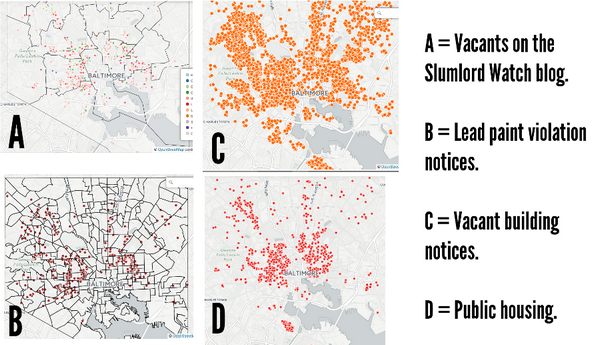Home health concerns and hazards in the Baltimore area
(Baltimore homeless often sleep under I-83 overpass. File photo.)
The health of the Baltimore residents is determined by more than the health care system in the region. Health is strongly dependent on the environment in which humans spend most of their times. And households and office buildings fall into this particular category. Households from all around the world are daily exposed to an array of threats. While many homeowners are tempted to think of their household as healthy, perfectly safe environments, the reality is different. Health also depends on geographical coordinates, varying from country to country, and even from neighborhood to neighborhood. Obviously, poorer areas of a city are more exposed to various health threats than wealthier areas are. And this phenomenon appears in Baltimore’s case as well.
Data and Statistics on the Baltimore City Health Coordinates
Geographically, Baltimore is located 30 miles north Washington DC, on the coast of Chesapeake Bay. The city has nowadays a population well over 600,000 but, unfortunately, dropping. The population density in the city is well above 7,000 per square mile. When discussing health matters in a city, the age of the residents is an important coordinate we have to take into account. Individuals aged 18 and 64 accounts for more than two-thirds of the Baltimore population. Apparently, the socio-economic coordinates matter enormously when discussing home-related health conditions. Some 2009 data suggests that more than 10% of the Baltimore households were having a monthly income below the FPL. Education also has a word to say in terms of health, in all societies. Obviously, there is a close correlation between the educational level and income in a household; and as a result, the income is related closely to the health status and health access of the inhabitants of a household. Across America, poor individuals are more likely to die at a young age, before 65. Those with less education are also more likely to engage in unhealthy behaviors and create a damaging indoor living environment for themselves and their families. In the Baltimore area, the number of population with a bachelor degree is lower than in the rest of Maryland, and below the USA average.
In Baltimore city, just like in others cities across the USA, there is a strong relationship between the living conditions and health. Just like in any other regions of the USA, mold exposure, pests, lead exposure and extreme cold or heat influence the health of the inhabitants and rise very demanding health concerns. In this particular city, the living conditions that endanger the most the well-being of the inhabitants were identified as below:
- Electricity shut off due to the inability to pay the bills;
- The number of pest accusations registered per household;
- The number of lead violations per housing unit;
- The number of liquor stores per capita;
- The number of households that lack proper living conditions (e.g. without attic insulation, without running water etc.)
 Health Concerns Correlated with Improper Living Condition in Baltimore City
Health Concerns Correlated with Improper Living Condition in Baltimore City
As the Baltimore population seems to meet all the necessary coordinates for an unhealthy population, we have to identify those burning health matters caused by improper living conditions.
- Asthma – Baltimore city has the highest asthma prevalence in Maryland and most asthma-related emergency room visits and hospitalization days, but also asthma-related deaths in Maryland. The usual recommendation, in this case, is a proper assessment of mold infestation and a recommended action plan, by a competent body. Also, proper home insulation, a decreased level of indoor humidity (thus investments in a dehumidifier) will help eliminate the health threats and conditions, including asthma, associated with poor living conditions.
- Lead poisoning– homes built previously in 1978 are certain sources of lead poisoning. Until then, the compound was widely used in paints, construction materials, pipes and so on. Toys were also manufactured out of materials containing high lead levels. As a big part of the Baltimore population is living in poverty, they are more likely to rent or purchase properties that show high lead concentrations. As many sellers have to disclose the status of their property (with or without lead signs), the prices for those contaminated properties are significantly lower. Also, poor children are more likely to receive old toys, which contain high lead concentration, being unknowingly exposed to this contaminant. Unfortunately, lead poisoning has irreversible health effects, from physical disabilities to mental disabilities. Also, mothers that were exposed to lead while pregnant are more likely to give birth to children with deformities and physical or mental delays.
 As these health concerns are characteristic to many other areas and cities in the US, Baltimore meets all the necessary coordinates to show a higher prevalence. The “Safe at Home” program is a program that aims to help families, especially children in the area, to prevent and combat the effects of unhealthy living conditions, such as asthma and lead poisoning. While poverty and the lack of education may lead to the presented issues, some simple yet effective combative measures may help the Baltimore residents live healthier lives.
As these health concerns are characteristic to many other areas and cities in the US, Baltimore meets all the necessary coordinates to show a higher prevalence. The “Safe at Home” program is a program that aims to help families, especially children in the area, to prevent and combat the effects of unhealthy living conditions, such as asthma and lead poisoning. While poverty and the lack of education may lead to the presented issues, some simple yet effective combative measures may help the Baltimore residents live healthier lives.
